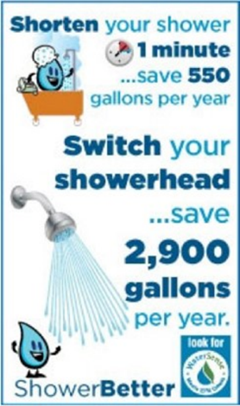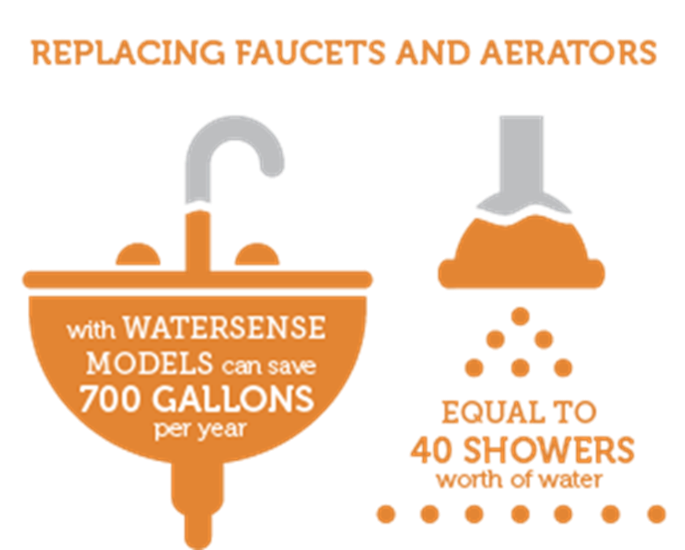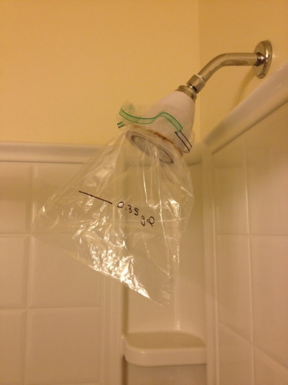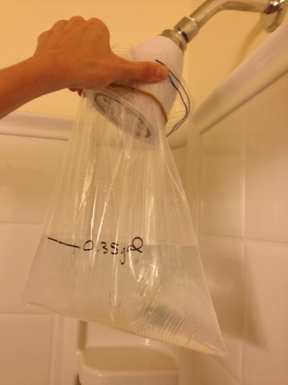Scope
Install WaterSense® labeled showerheads which can reduce water use in the shower by 20%.
Showerheads – All showerheads shall be WaterSense labeled showerheads. This includes fixed showerheads that direct water onto a user (excluding body sprays) for bathing purposes and hand-held showers. The showerhead must have a flow rate that does not exceed 2.0 gallons per minute (gpm) (7.6 liters per minute [lpm]).
Verify with your chosen WaterSense Approved Certification Method whether there are additional requirements or parameters for the installation of showerheads as these may vary.
See the Compliance Tab for links to related codes and standards and voluntary federal energy-efficiency program requirements.
Description
Showering is one of the leading uses of water inside the home, representing approximately 17% of annual residential indoor water use in the United States. Assuming there are 300 million people in the United States using 11.6 gallons of water per shower, about 1.2 trillion gallons of water are consumed for showering each year. The U.S. Environmental Protection Agency’s (EPA’s) WaterSense® program released its final specification for showerheads on March 4, 2010, to further improve the nation’s water and energy efficiency by raising consumer awareness and promoting the use of more efficient showerheads.


Install WaterSense® labeled showerheads that can reduce water use in the shower by 20%.


WaterSense collaborated with the American Society of Mechanical Engineers/Canadian Standards Association Joint Harmonization Task Force to develop the specification criteria for high-efficiency showerheads. This task force is open to the public and comprises a wide variety of stakeholders, including showerhead manufacturers, water and energy utilities, testing laboratories, consultants, and other water efficiency and conservation specialists. Their participation, resources, and expertise enabled WaterSense to evaluate showerhead efficiency and performance and develop meaningful testing protocols that can effectively differentiate showerhead performance.
Prior to the task force’s work, there were no universally accepted criteria for measuring showerhead performance. Federal water efficiency legislation and national performance standards only establish product flow rates that dictate water consumption—they do not address what makes a satisfactory, or unsatisfactory, shower. With the showerhead specification, WaterSense and the task force have bridged this consumer information gap by incorporating performance requirements for products seeking to earn the WaterSense label. The requirements address flow rates across a range of pressures, spray force, and spray coverage, three key attributes of showerhead performance, according to consumer testing. These new requirements are designed to ensure a high level of performance and user satisfaction with high-efficiency showerheads.
Manufacturers are required by law to mark showerheads with the maximum flow rate. The showerhead marking will indicate if a showerhead meets the WaterSense maximum flow rate. To determine if the product meets all aspects of the WaterSense specification, look for the WaterSense label on the product packaging and documentation (the specification requires these materials to bear the WaterSense label).
The specification sets the maximum acceptable flow rate per shower compartment at 2.0 gallons per minute (gpm) of water.
The WaterSense website also provides a list of labeled showerheads in the Directory of WaterSense Labeled Products.
Success
Showerheads – The verifier will obtain a list of the make and model numbers for all showerheads installed in the home and verify that they have earned the WaterSense® label. The verifier will also check the maximum flow rate from the showerheads, similar to the test performed on kitchen sink and bathroom sink faucets. For showers, no more than 0.35 gallons of water should be collected by the verifier during the 10-second test.


Climate
With drought affecting various regions of the United States, WaterSense continuously seeks opportunities to collaborate with various stakeholders such as local municipalities, jurisdictions, and water districts – many of which have the opportunity to become WaterSense Partners. By including requirements for WaterSense products and/or WaterSense Home certification in drought mitigation plans, building codes, or urban development plans, stakeholders have been able to reduce water use in their localities.
Training
Compliance
Retrofit
Guidance for the measures described in this guide is applicable to both new and existing homes.
DOE’s Standard Work Specifications describes practices to complete whole-house energy upgrades safely without injury or hazardous exposure in the section on Global Worker Safety. The Specifications also provide some specific guidance on showerheads and faucet aerators.
More
More Info.
Access to some references may require purchase from the publisher. While we continually update our database, links may have changed since posting. Please contact our webmaster if you find broken links.
The following authors and organizations contributed to the content in this Guide.
Sales
Water Efficient Indoor =

Water is an increasingly precious commodity. Choices in fixtures, appliances, and even design can help conserve this vital resource.



